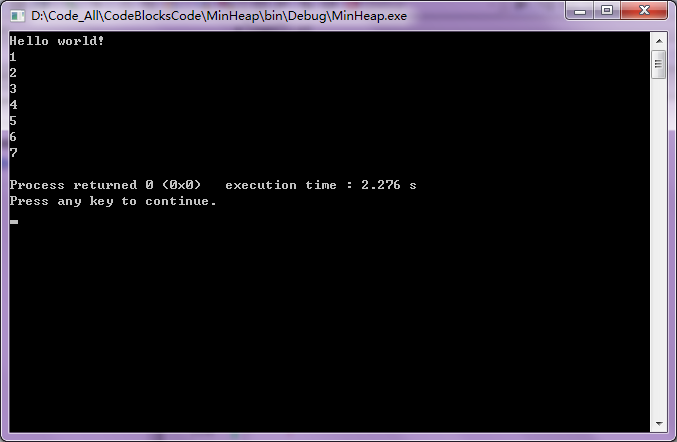上次用Java实现了最大堆的封装,这次就来写一下最小堆的实现吧
插入函数的思路:
向堆中插入元素有两种情况,一种是堆为空,那么就让插入值作为根节点即可;另一种是堆不为空,那么此时就要进行判断当前节点与其父节点的大小关系比较。此时仍有两种情况,一种是当前节点大于父节点,这样正是我们所希望的;另一种是当前节点的值小于父节点,那么就要将二者的值进行调换,然后记得更新当前节点为原来父节点的位置,而父节点的位置同样需要更新(循环正常终止的时候说明已经到了根节点,此时最小值必定为根节点)
bool Insert(T data){ if(currentPos==MaxSize){ cout<<"Sorry , this heap is full!"<<endl; return false; } currentPos++; int targetPos=currentPos-1; heap[targetPos]=data; while(targetPos>0){ int parentPos=(targetPos-1)/2; if(heap[parentPos]<heap[targetPos]){ break; }else{ heap[targetPos]=heap[parentPos]; targetPos=parentPos; } } return true; } //存在的bug是对根节点的大小比较,因为有可能targetPos=0而退出,此时就缺少了一次比较
- 1
- 2
- 3
- 4
- 5
- 6
- 7
- 8
- 9
- 10
- 11
- 12
- 13
- 14
- 15
- 16
- 17
- 18
- 19
- 20
siftDown调整过程思路:
给定要进行调整的节点的下标,我们只需要让它和它的两个子节点中最小的那个比较即可(前提是当前节点不是叶子节点),需要注意的是要先保存当前节点的值,比较之后按大小调整顺序即可。
void siftDown(int siftPos){ int siftPosition=siftPos; T temp=heap[siftPosition]; int minChildPos=2*siftPosition+1; while(minChildPos<currentPos){ //保证比较的条件成立 if((minChildPos<currentPos-1)&&(heap[minChildPos]>heap[minChildPos+1])){ minChildPos++; } if(temp<heap[minChildPos]){ break; }else{ heap[siftPosition]=heap[minChildPos]; siftPosition=minChildPos; minChildPos=2*siftPosition+1; } } //作用:当要进行调换的位置不满足循环要求时,说明要进行调换的位置是叶子节点,那就不需要变换咯(这里也包括正常比较情况,可正常使用) heap[siftPosition]=temp; }
- 1
- 2
- 3
- 4
- 5
- 6
- 7
- 8
- 9
- 10
- 11
- 12
- 13
- 14
- 15
- 16
- 17
- 18
- 19
- 20
- 21
删除对顶元素
需要注意的是currentPos的大小要实时的进行更新,然后返回所删除的堆顶元素即可
T& deleteTop(){ if(currentPos<0){ cout<<"Sorry ,this heap is empty!"<<endl; } T target=heap[0]; heap[0]=heap[currentPos-1]; currentPos--; siftDown(0); return target; }
- 1
- 2
- 3
- 4
- 5
- 6
- 7
- 8
- 9
- 10
下面是完整的C++关于最小堆的实现的代码
#include <iostream>using namespace std;template<class T>class MinHeap{ T *heap; int MaxSize; int currentPos;public: MinHeap(int MS){ heap=new T[MS]; currentPos=0; MaxSize=MS; } bool Insert(T data){ if(currentPos==MaxSize){ cout<<"Sorry , this heap is full!"<<endl; return false; } currentPos++; int targetPos=currentPos-1; heap[targetPos]=data; while(targetPos>0){ int parentPos=(targetPos-1)/2; if(heap[parentPos]<heap[targetPos]){ break; }else{ heap[targetPos]=heap[parentPos]; targetPos=parentPos; } } return true; } void siftDown(int siftPos){ int siftPosition=siftPos; T temp=heap[siftPosition]; int minChildPos=2*siftPosition+1; while(minChildPos<currentPos){ //保证比较的条件成立 if((minChildPos<currentPos-1)&&(heap[minChildPos]>heap[minChildPos+1])){ minChildPos++; } if(temp<heap[minChildPos]){ break; }else{ heap[siftPosition]=heap[minChildPos]; siftPosition=minChildPos; minChildPos=2*siftPosition+1; } } //作用:当要进行调换的位置不满足循环要求时,说明要进行调换的位置是叶子节点,那就不需要变换咯 heap[siftPosition]=temp; //////////////////////////////////////////// } T& deleteTop(){ if(currentPos<0){ cout<<"Sorry ,this heap is empty!"<<endl; } T target=heap[0]; heap[0]=heap[currentPos-1]; currentPos--; siftDown(0); return target; }};int main(){ cout << "Hello world!" << endl; MinHeap<int> minHeap(7); minHeap.Insert(1); minHeap.Insert(2); minHeap.Insert(4); minHeap.Insert(3); minHeap.Insert(6); minHeap.Insert(7); minHeap.Insert(5); for(int i=1;i<=7;i++){ cout<<minHeap.deleteTop()<<endl; } return 0;}
- 1
- 2
- 3
- 4
- 5
- 6
- 7
- 8
- 9
- 10
- 11
- 12
- 13
- 14
- 15
- 16
- 17
- 18
- 19
- 20
- 21
- 22
- 23
- 24
- 25
- 26
- 27
- 28
- 29
- 30
- 31
- 32
- 33
- 34
- 35
- 36
- 37
- 38
- 39
- 40
- 41
- 42
- 43
- 44
- 45
- 46
- 47
- 48
- 49
- 50
- 51
- 52
- 53
- 54
- 55
- 56
- 57
- 58
- 59
- 60
- 61
- 62
- 63
- 64
- 65
- 66
- 67
- 68
- 69
- 70
- 71
- 72
- 73
- 74
- 75
- 76
- 77
- 78
- 79
- 80
- 81
- 82
- 83
- 84
- 85
- 86
- 87
- 88
- 89
- 90
程序运行结果如下
总结:
代码中存在一定得错误,出在 Insert函数中。个人认为需要对targetPos为0的特殊情况再加一层判断,估计就能解决。但是对正常添加元素还是能得到比较正常的结果的。
再分享一下我老师大神的人工智能教程吧。零基础!通俗易懂!风趣幽默!还带黄段子!希望你也加入到我们人工智能的队伍中来!https://blog.csdn.net/jiangjunshow
